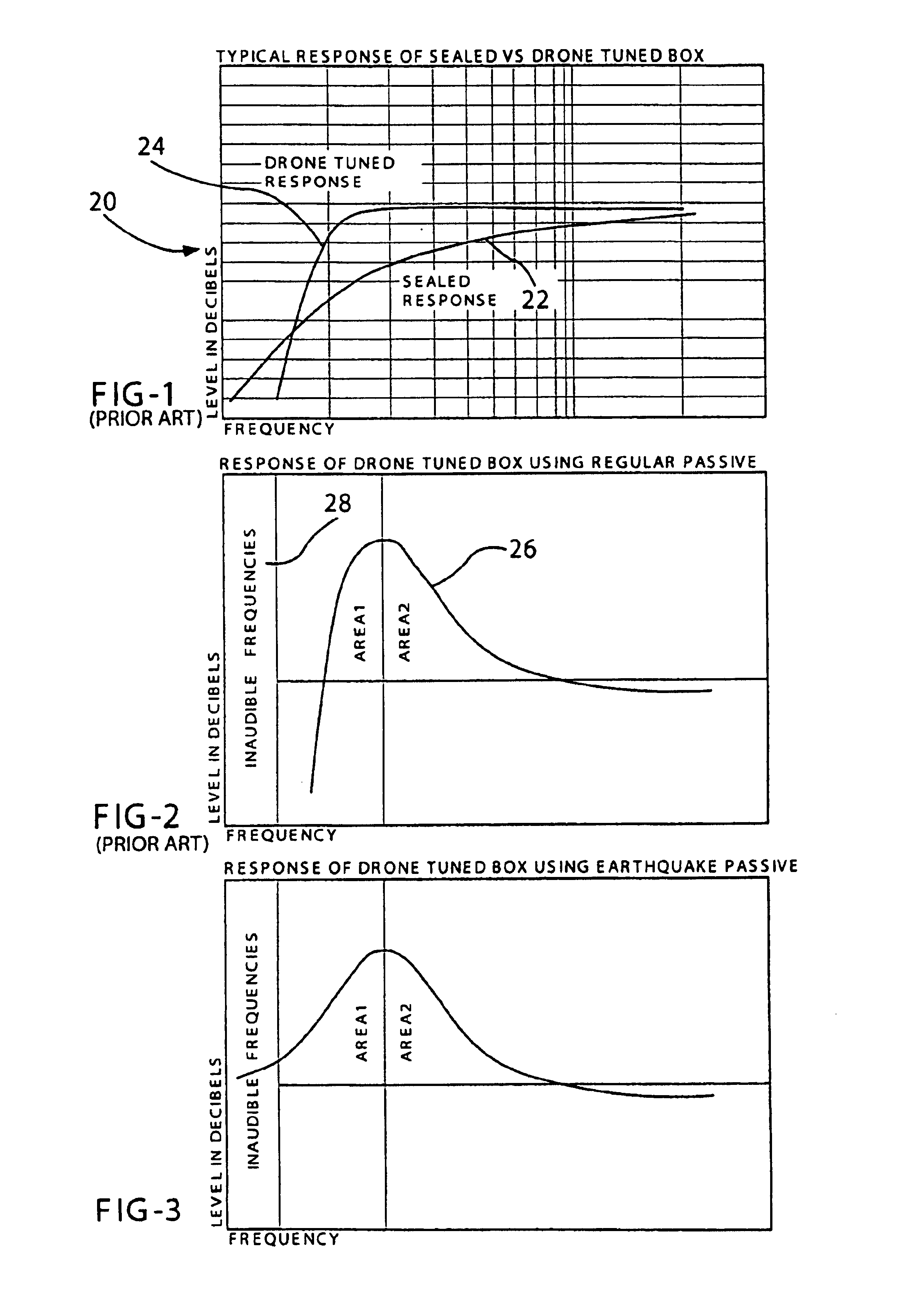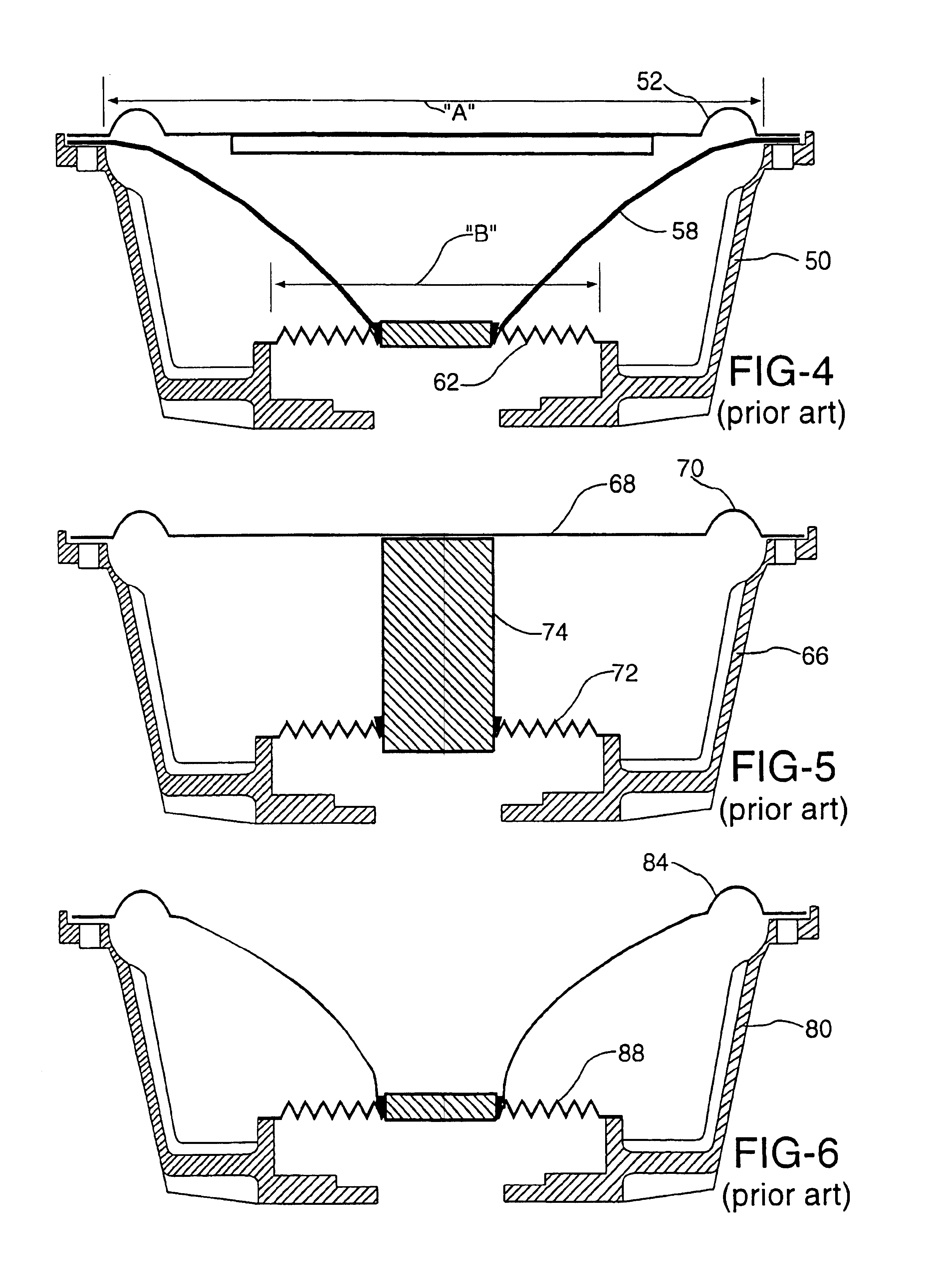Low profile audio speaker
a low-profile, speaker technology, applied in the direction of transducer diaphragms, electromechanical transducers, instruments, etc., can solve the problems of low frequency that requires large displacement of moveable radiator elements, unmanageable use of open ports or open ports and tubes, and inability to control the relative distortion of speakers, etc., to achieve high sound quality, low noise, and low noise
- Summary
- Abstract
- Description
- Claims
- Application Information
AI Technical Summary
Benefits of technology
Problems solved by technology
Method used
Image
Examples
first embodiment
FIG. 36 show a first embodiment low profile, overhung, shallow speaker design with FIG. 36A in the unexcited position, FIG. 36B in the maximum outward excursion position, and FIG. 36C in the maximum inward excursion position. Included is a low profile frame or basket 402 that mounts to baffle board 400 in the installed location. Basket 402 has a bottom thickness of “H”. In the bottom center of basket 402 is a typical overhung magnet / voice coil audio motor with an upwardly extending steel doughnut with an outwardly extending flange 410 with that flange having a thickness of “T”. Mounted on the flange of doughnut 410 is a circular magnet 406 having a center hole that has a larger diameter than the diameter of the upwardly extending portion of the doughnut. Magnet 406 has a thickness of 2α. On top of magnet 406 is a steel ring 408 having outer and inner diameters that are approximately the same as those diameters of magnet 406. Ring 408 also has a thickness “T”.
Additionally, there is a...
second embodiment
FIG. 39 shows an overhung, low profile speaker that is similar to that of FIG. 36A, the difference being that surrounds 418 and 420 have been replaced with a single bladder 422. In construction, bladder 422 is similar to a bicycle tube with the outer most side connected to inside top edge of basket 402 and an opposite side connected to the bottom of the outer most leg of the “V” shaped edge of diaphragm 404. Mounted in that way, a portion of bladder 422 extends upward like surround 418 while another portion extends downward into basket 420 like surround 420. In operation, bladder 422 performs similarly to the combination of surrounds 418 and 420 as discussed above in relation to FIGS. 36A, 36B and 36C.
By connecting the outer most side of bladder 422 to a lower point within basket 402 that is approximately horizontally even with the underside of the outer most leg of the “V” shaped edge of the diaphragm rocking of the diaphragm during speaker operation is minimized. Bladder 422 could...
fourth embodiment
FIG. 37 show an overhung, low profile speaker of the present invention. This embodiment, as will be seen, has built in stops that define the maximum inward and outward travel of the diaphragm. Included in this embodiment is a speaker basket 402′ with an outwardly extending upper flange that mounts to baffle board 400 of the mounting location of the speaker. Basket 402′ has a bottom thickness “H”. Mounted centrally within basket 402′ is a post 428 having a threaded upper end 430 with the overall height of post 428 being less than the height of basket 402′ from the bottom to the mounting flange. Also included is steel ring 408 magnetically adhering to the bottom of circular magnet 406 which in turn magnetically adheres to the flange of circular steel doughnut 410′ with a hole therethrough that is tapped at the upper end. The flange of doughnut 410′ and ring 408 each have a thickness “T”, and magnet 406 has a thickness 2α′ (note the distance α′ in this figure is not necessarily the sam...
PUM
 Login to View More
Login to View More Abstract
Description
Claims
Application Information
 Login to View More
Login to View More - R&D
- Intellectual Property
- Life Sciences
- Materials
- Tech Scout
- Unparalleled Data Quality
- Higher Quality Content
- 60% Fewer Hallucinations
Browse by: Latest US Patents, China's latest patents, Technical Efficacy Thesaurus, Application Domain, Technology Topic, Popular Technical Reports.
© 2025 PatSnap. All rights reserved.Legal|Privacy policy|Modern Slavery Act Transparency Statement|Sitemap|About US| Contact US: help@patsnap.com



